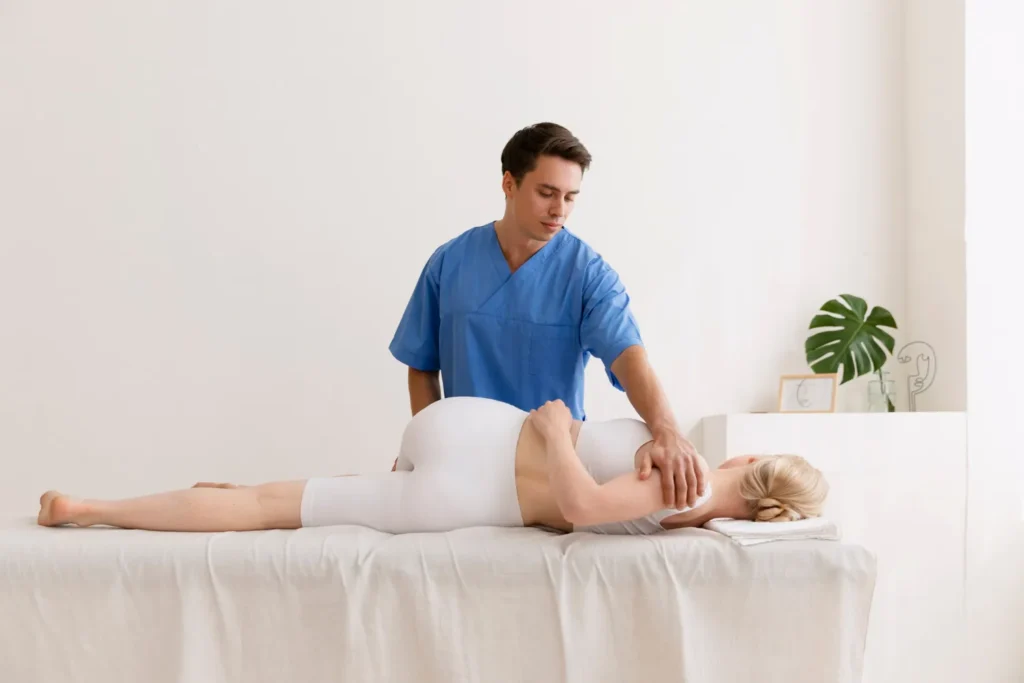The importance of Physical Therapy after Hip Replacement can’t be overstated. If you’re wondering how to speed up your recovery after hip replacement and get back on your feet, this guide is for you. Physical therapy is crucial for regaining strength, mobility, and confidence after hip replacement surgery. It helps reduce pain, prevent complications, and ensures you make the most out of your new joint.
In this guide, we’ll delve into the specific benefits of physical therapy post hip-surgery, explore the different phases of rehabilitation, and provide tips to maximize your recovery. Whether you’re preparing for surgery or are in the early stages of recovery, understanding the role of physical therapy can make a significant difference in your journey. Ready to uncover the secrets to a smooth, pain-free rehab? Let’s get started!
Understanding Hip Replacement Surgery
Understanding the intricacies of hip replacements surgery helps to appreciate why the procedure is performed and what patients can expect post-surgery. This section delves into what the surgery entails, the conditions that necessitate it, and the anticipated outcomes.

What is Hip Replacement Surgery?
Hip replacement surgery is a medical procedure in which a surgeon removes the damaged or diseased parts of the hip joint and replaces them with artificial components. These components are typically made of metal, ceramic, and plastic. The goal is to alleviate pain, improve mobility, and enhance the overall quality of life.
Common Reasons for Hip Replacement
Several conditions can lead to the need for hip replacement surgery. The most common ones include:
- Osteoarthritis: This degenerative joint disease causes the cartilage in the hip joint to break down, leading to pain and stiffness.
- Rheumatoid Arthritis: An autoimmune condition that causes inflammation in the joints, leading to pain and swelling.
- Hip Fractures: Severe fractures, often due to falls or accidents, can damage the hip joint irreparably.
- Avascular Necrosis: This condition occurs when there is a loss of blood supply to the bone, causing the bone tissue to die and the joint to collapse.
Why Physical Therapy is Crucial Post-Surgery?
Physical therapy is crucial for several reasons:
- Restores Mobility: Post surgery, patients often experience stiffness and reduced range of motion. Physical therapy helps to stretch and strengthen the muscles around the hip joint, improving flexibility and mobility.
- Prevents Complications: Without proper movement, patients risk developing blood clots, deep vein thrombosis, and muscle atrophy. Physical therapy encourages blood circulation and keeps the muscles engaged.
- Pain Management: Through targeted exercises and manual therapy, physical therapists can help manage and reduce pain.
- Enhances Muscle Strength: Strengthening the muscles around the hip joint is vital for stability and to prevent future injuries.
- Speeds Up Recovery: A structured physical therapy program can significantly reduce recovery time, allowing patients to return to their daily activities sooner.
Benefits of Physical Therapy after Hip Replacement

The benefits of physical therapy after hip replacement extend far beyond merely improving physical health. This section explores how physical therapy enhances mobility, muscle strength, pain management, and recovery time, providing a holistic recovery experience.
Improved Mobility
One of the primary benefits of physical therapy is improved mobility. After hip surgery, it’s common for patients to experience stiffness and a limited range of motion. Physical therapists work with patients to perform exercises that gradually restore flexibility and movement. These exercises are designed to stretch the muscles and soft tissues around the hip joint, making it easier for patients to perform everyday tasks such as walking, bending, and climbing stairs.
Enhanced Muscle Strength
Strengthening the muscles around the hip joint is crucial for a successful recovery. Physical therapy focuses on exercises that target the hip flexors, glutes, and quadriceps. Strong muscles provide better support to the new hip joint, reducing the risk of dislocation and other complications. Additionally, increased muscle strength improves overall stability and balance, which is essential for preventing falls and further injuries.
Pain Management
Pain is a common concern for patients after hip replacement surgery. Physical therapy includes techniques such as manual therapy, ice and heat treatments, and specific exercises to manage and reduce pain. By addressing pain early in the recovery process, patients can engage more fully in their rehabilitation therapy exercises, which in turn promotes faster healing.
Faster Recovery Time
A well-structured physical therapy program can significantly accelerate the recovery process. By following a tailored exercise regimen, patients can regain their strength and mobility more quickly, allowing them to return to their normal activities sooner. This not only enhances their quality of life but also reduces the overall healthcare costs associated with prolonged recovery periods.
Types of Physical Therapy Exercises Post Hip Replacement
Different types of physical therapy exercises target various aspects of recovery, from improving range of motion to building muscle strength and enhancing coordination. Understanding these exercises helps patients know what to expect during their rehabilitation journey.
Range of Motion Exercises
Range of motion (ROM) exercises are designed to improve the flexibility of the hip joint. These exercises help to reduce stiffness and increase the joint’s ability to move through its full range. Examples of ROM exercises include:
- Hip Abduction: Lying on your back, slowly move your leg out to the side and back to the center.
- Knee to Chest: While lying on your back, gently pull one knee towards your chest and hold for a few seconds before releasing.
- Ankle Pumps: Moving your foot up and down while lying on your back to encourage blood circulation and reduce swelling.
Strengthening Exercises
Strengthening exercises focus on building the muscles around the hip joint. These exercises are crucial for providing support and stability to the new hip. Examples include:
- Bridges: Lying on your back with your knees bent, lift your hips off the ground, and hold for a few seconds before lowering.
- Leg Raises: Lying on your side, lift your top leg towards the ceiling and lower it back down.
- Step-Ups: Using a step or low platform, step up with one foot and bring the other foot to meet it, then step down and repeat.
Balance and Coordination Exercises
Improving balance and coordination is essential to prevent falls and ensure a smooth recovery. Physical therapists often incorporate exercises such as:
- Single-Leg Stands: Standing on one leg while holding onto a stable surface for support.
- Heel-to-Toe Walk: Walking in a straight line, placing one foot directly in front of the other.
Gait Training
Gait training helps patients relearn how to walk correctly and efficiently. This involves practicing walking with assistive devices like crutches or a walker initially and then progressing to walking unaided. Physical therapists will focus on improving the patient’s walking pattern, ensuring proper foot placement, and addressing any limp or imbalance.
The Physical Therapy Timeline After Hip Replacement

The timeline for physical therapy after hip replacement is divided into different phases, each with specific goals and exercises. Understanding this timeline helps patients know what to expect at various stages of their recovery.
Immediate Post-Surgery Phase
Physical therapy begins almost immediately after hip replacement surgery. During the first few days, the focus is on gentle movements and exercises to prevent blood clots and maintain circulation. Patients are encouraged to do simple exercises such as ankle pumps, heel slides, and isometric contractions to keep the muscles active without straining the new hip joint.
Intermediate Recovery Phase
The intermediate phase, which lasts from a few days to a few weeks after surgery, involves more intensive exercises. Patients work on regaining strength and increasing their range of motion. Physical therapists introduce exercises such as bridges, leg raises, and hip abductions. Walking with assistive devices like crutches or a walker is also emphasized during this period.
Long-Term Rehabilitation Phase
The long-term rehabilitation phase can last several months, depending on the patient’s progress. This phase focuses on advanced strengthening and balance exercises, gait training, and gradually returning to normal activities. Patients will continue to work on improving their mobility and muscle strength, aiming to integrate the new hip joint into their daily lives fully.
The Psychological Benefits of Physical Therapy Post Hip Replacement
The psychological benefits of physical therapy are often overlooked but are equally important as the physical aspects. This section explores how physical therapy can enhance mental well-being during the recovery process.
Boosting Confidence and Motivation
Undergoing hip replacement surgery can be daunting, and the recovery process can be equally challenging. Physical therapy plays a significant role in boosting patients’ confidence and motivation. By setting achievable goals and celebrating progress, therapists help patients stay positive and focused on their recovery journey.
Reducing Anxiety and Depression
Chronic pain and limited mobility can take a toll on mental health, leading to anxiety and depression. Physical therapy provides a structured routine and a sense of purpose, which can help alleviate these feelings. Additionally, regular physical activity releases endorphins, the body’s natural mood lifters, contributing to improved mental well-being.
Conclusion – Importance of Physical Therapy after Hip Replacement
The Importance of Physical Therapy after Hip Replacement is paramount and plays an indispensable role in the recovery journey. This crucial phase not only facilitates a swift return to daily activities but also ensures that patients can do so with enhanced mobility and reduced discomfort. Physical therapy post-surgery is not just about healing; it’s a transformative process that empowers patients to regain strength and stability, thereby markedly elevating their quality of life.
Engaging in a well-structured physical therapy program under the guidance of skilled professionals allows for the proper execution of exercises specifically designed to target and strengthen the muscles around the new hip joint. This meticulous approach helps prevent complications and accelerates the overall healing process. Additionally, these therapy sessions provide a platform for patients to monitor their progress and set realistic goals, which is crucial for staying motivated throughout the recovery period.
FAQs About Importance of Physical Therapy after Hip Replacement
What should I expect during physical therapy sessions?
During physical therapy sessions, you can expect a combination of exercises, manual therapy, and education. Your therapist will guide you through movements designed to improve your range of motion, strength, and balance. They will also provide instructions on how to perform exercises safely at home.
How long will I need physical therapy after hip replacement?
The duration of physical therapy varies depending on individual progress and recovery goals. Most patients require treatment for several months, with the frequency and intensity of sessions gradually decreasing as they regain strength and mobility.
Can I do physical therapy exercises at home?
Yes, home exercises are a crucial part of the recovery process. Your physical therapist will provide you with a set of exercises to perform at home. Consistently doing these exercises will help reinforce the gains made during therapy sessions and speed up your recovery.
What are the signs that I need more physical therapy?
Signs that you may need more physical therapy include persistent pain, stiffness, or limited mobility. If you are struggling with daily activities or feel that your progress has plateaued, consult your physical therapist. They can reassess your condition and adjust your treatment plan accordingly.
How can I ensure a smooth recovery post-hip replacement?
Ensuring a smooth recovery involves:
- Adhering to your physical therapy program
- Maintaining open communication with your therapist
- Incorporating healthy lifestyle habits
Follow your therapist’s advice, stay consistent with exercises, and take care of your overall health to support the healing process.





